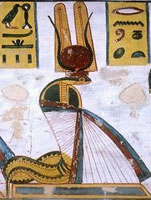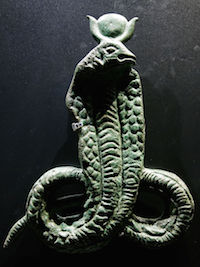

Renenutet (also known as Termuthis, Ernutet, Renenet) was a cobra goddess from the Delta area. She was a powerful goddess, whose gaze destroyed her enemies. However, the ancient Egyptians had no reason to fear her, as she offered them protection in many areas of their life.
She was depicted either as a woman, a cobra, or a woman with the head of a cobra wearing a double plumed headdress or the solar disk. Renenutet was also depicted with a lion’s head, like Hathor in her form of the “Eye of Ra”. In the underworld she became a fearsome fire-breathing cobra who could kill with one gaze.

Her name may derive from the words “rnn” (to bring up, or nurse) and “wtt” (snake), but others have suggest that “rnnt” can mean “fortune” or “riches”.
A further possibility is that the first syllable is “rn”, translated as “name”. This would certainly fit with her role in naming children, but those who support this view tend to translate her name as “She who is in the name” which doesn’t actually fit the rest of the hieroglyphs. This brings us to a further possibility. Some sources refer to a separate snake goddess named Renenet, who was a goddess of nursing. They may well be one and the same, or they could have become merged over time, but it is also possible that the two have simply become confused by historians.

Renenutet was sometimes considered to be the wife of Geb (the earth god) and the mother of Nehebkau (the snake god who guarded the entrance to the underworld and protected Ra as he passed through every night), but other traditions held that she was married to Sobek or Shai, the god of destiny. She was the mother of Nepri, the personification of corn, who was closely associated with Osiris. However, as an example of perfect motherhood, she was merged with Isis (Osiris’s wife) as Isermithis or Thermouthis.
To the ancient Egyptians, names were words of great power. As the Goddess of suckling, Renenutet gave each newborn baby a secret name along with its mother’s milk. In this role she was given the epithet “She Who Rears”. She also protected children from curses. In fact, the child was said to “have Renenutet upon his shoulder from his first day”. In this role she was linked with Meskhenet, a goddess of childbirth, who actually oversaw the labour.
The ancient Egyptians believed that in order for a person to enjoy eternal life, their image and their name must survive. As Renenutet gave each person their name, she was linked with Shai, as a goddess of fate. Ramesses II stated that he was the “Lord of Shai and Creator of Renentet” as an indication of his power to control his own fate.
Renenutet and Shai were often depicted with Thoth and were sometimes named “the hands of Thoth”. In the Litany of Re (New Kingdom) she appears in the underworld as the “Lady of Justification”, associating her with the goddess Ma’at.

According to the Pyramid Texts, Renenutet was the goddess of plenty and good fortune. Snakes were often seen in the fields around harvest time, hunting the rodents who would threaten the crop. As a result, Renenutet was considered to protect the harvest and given the epithets “Goddess of the Double Granary”, the “Lady of Fertile Fields”, and the “Lady of Granaries”.
Amenemhet III and Amenemhet IV dedicated a temple to Renenutet, Sobek, and Horus at Dja (known to the Greeks as Narmouthis or Harmounthis and now called Medinet Madi) which was expanded during the Ptolemaic Period. In this temple an annual harvest festival was held in her honour during which a quantity of the best quality produce was dedicated to her, and throughout Egypt shrines to her were built in areas where wine was brewed.
Renenutet was also linked to the coming of the inundation and by the later period presided over the eighth month of the ancient Egyptian calendar known to us by the Greek name “Parmutit”.
From the early period, she was seen as protector of the pharaoh in the netherworld, with the epithet “Nourishing Snake”. Renenutet imbued his clothing with power which repelled his enemies. By the New Kingdom her power extended to the mummification ritual during which she imbued the mummy wrappings with magical power, and in the Ptolemaic Period this role was honoured with the epithet “The Lady of the Robes”.
Bibliography
- Bard, Kathryn (2008) An introduction to the Archaeology of Ancient Egypt
- Budge, E Wallis (1904) The Gods of the Egyptians
- Goodenough, Simon (1997) Egyptian Mythology
- Watterson, Barbara (1996) Gods of Ancient Egypt
- Wilkinson, Richard H. (2003) The Complete Gods and Goddesses of Ancient Egypt
Copyright J Hill 2016